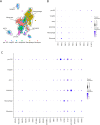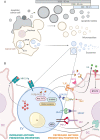Dendritic cell subsets in cancer immunity and tumor antigen sensing
- PMID: 36949244
- PMCID: PMC10203372
- DOI: 10.1038/s41423-023-00990-6
Dendritic cell subsets in cancer immunity and tumor antigen sensing
Abstract
Dendritic cells (DCs) exhibit a specialized antigen-presenting function and play crucial roles in both innate and adaptive immune responses. Due to their ability to cross-present tumor cell-associated antigens to naïve T cells, DCs are instrumental in the generation of specific T-cell-mediated antitumor effector responses in the control of tumor growth and tumor cell dissemination. Within an immunosuppressive tumor microenvironment, DC antitumor functions can, however, be severely impaired. In this review, we focus on the mechanisms of DC capture and activation by tumor cell antigens and the role of the tumor microenvironment in shaping DC functions, taking advantage of recent studies showing the phenotype acquisition, transcriptional state and functional programs revealed by scRNA-seq analysis. The therapeutic potential of DC-mediated tumor antigen sensing in priming antitumor immunity is also discussed.
Keywords: Dendritic cell subsets; Immune cell death; Innate immune sensing; Migration; Tumor microenvironment; Tumor-derived extracellular vesicles.
© 2023. The Author(s).
Conflict of interest statement
The authors declare no competing interests.
Figures




References
Publication types
MeSH terms
Substances
LinkOut - more resources
Full Text Sources
Medical

